10.DRF-认证
Django rest framework源码分析(1)----认证
一、基础
1.1.安装
两种方式:
- github
- pip直接安装
pip install djangorestframework
1.2.需要先了解的一些知识
理解下面两个知识点非常重要,django-rest-framework源码中到处都是基于CBV和面向对象的封装
(1)面向对象封装的两大特性
把同一类方法封装到类中
将数据封装到对象中
(2)CBV
基于反射实现根据请求方式不同,执行不同的方法
原理:url-->view方法-->dispatch方法(反射执行其它方法:GET/POST/PUT/DELETE等等)
二、简单实例
2.1.settings
先创建一个project和一个app(我这里命名为API)
首先要在settings的app中添加
INSTALLED_APPS = [
'rest_framework',
]
2.2.url
from django.contrib import admin
from django.urls import path
from API.views import AuthView
urlpatterns = [
path('admin/', admin.site.urls),
path('api/v1/auth/',AuthView.as_view()),
]
2.3.models
一个保存用户的信息
一个保存用户登录成功后的token
from django.db import models
class UserInfo(models.Model):
USER_TYPE = (
(1,'普通用户'),
(2,'VIP'),
(3,'SVIP')
)
user_type = models.IntegerField(choices=USER_TYPE)
username = models.CharField(max_length=32)
password = models.CharField(max_length=64)
class UserToken(models.Model):
user = models.OneToOneField(UserInfo,on_delete=models.CASCADE)
token = models.CharField(max_length=64)
2.4.views
用户登录(返回token并保存到数据库)
from django.shortcuts import render
from django.http import JsonResponse
from rest_framework.views import APIView
from API import models
def md5(user):
import hashlib
import time
#当前时间,相当于生成一个随机的字符串
ctime = str(time.time())
m = hashlib.md5(bytes(user,encoding='utf-8'))
m.update(bytes(ctime,encoding='utf-8'))
return m.hexdigest()
class AuthView(object):
def post(self,request,*args,**kwargs):
ret = {'code':1000,'msg':None}
try:
user = request._request.POST.get('username')
pwd = request._request.POST.get('password')
obj = models.UserInfo.objects.filter(username=user,password=pwd).first()
if not obj:
ret['code'] = 1001
ret['msg'] = '用户名或密码错误'
#为用户创建token
token = md5(user)
#存在就更新,不存在就创建
models.UserToken.objects.update_or_create(user=obj,defaults={'token':token})
ret['token'] = token
except Exception as e:
ret['code'] = 1002
ret['msg'] = '请求异常'
return JsonResponse(ret)
2.5.利用postman发请求

如果用户名和密码正确的话 会生成token值,下次该用户再登录时,token的值就会更新
数据库中可以看到token的值

当用户名或密码错误时,抛出异常
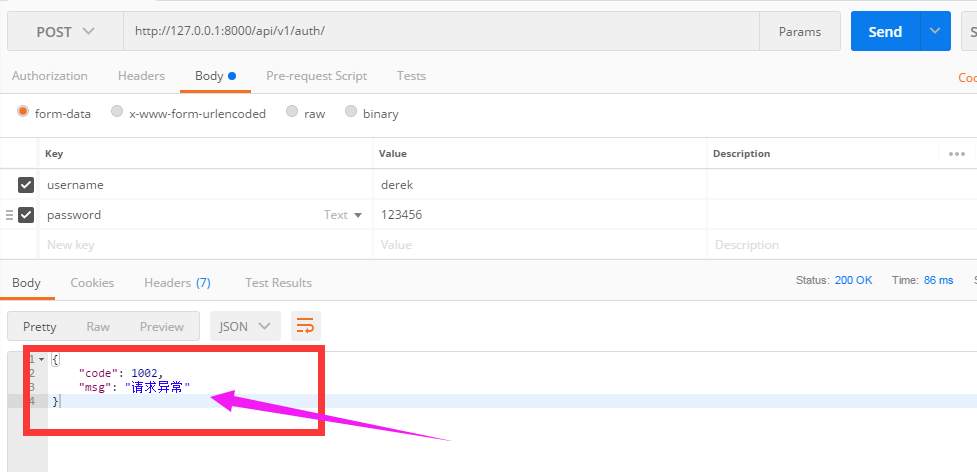
三、添加认证
基于上面的例子,添加一个认证的类
3.1.url
path('api/v1/order/',OrderView.as_view()),
3.2.views
from django.shortcuts import render,HttpResponse
from django.http import JsonResponse
from rest_framework.views import APIView
from API import models
from rest_framework.request import Request
from rest_framework import exceptions
from rest_framework.authentication import BasicAuthentication
ORDER_DICT = {
1:{
'name':'apple',
'price':15
},
2:{
'name':'dog',
'price':100
}
}
def md5(user):
import hashlib
import time
#当前时间,相当于生成一个随机的字符串
ctime = str(time.time())
m = hashlib.md5(bytes(user,encoding='utf-8'))
m.update(bytes(ctime,encoding='utf-8'))
return m.hexdigest()
class AuthView(object):
'''用于用户登录验证'''
def post(self,request,*args,**kwargs):
ret = {'code':1000,'msg':None}
try:
user = request._request.POST.get('username')
pwd = request._request.POST.get('password')
obj = models.UserInfo.objects.filter(username=user,password=pwd).first()
if not obj:
ret['code'] = 1001
ret['msg'] = '用户名或密码错误'
#为用户创建token
token = md5(user)
#存在就更新,不存在就创建
models.UserToken.objects.update_or_create(user=obj,defaults={'token':token})
ret['token'] = token
except Exception as e:
ret['code'] = 1002
ret['msg'] = '请求异常'
return JsonResponse(ret)
class Authentication(APIView):
'''认证'''
def authenticate(self,request):
token = request._request.GET.get('token')
token_obj = models.UserToken.objects.filter(token=token).first()
if not token_obj:
raise exceptions.AuthenticationFailed('用户认证失败')
#在rest framework内部会将这两个字段赋值给request,以供后续操作使用
return (token_obj.user,token_obj)
def authenticate_header(self, request):
pass
class OrderView(APIView):
'''订单相关业务'''
authentication_classes = [Authentication,] #添加认证
def get(self,request,*args,**kwargs):
#request.user
#request.auth
ret = {'code':1000,'msg':None,'data':None}
try:
ret['data'] = ORDER_DICT
except Exception as e:
pass
return JsonResponse(ret)
3.3用postman发get请求
请求的时候没有带token,可以看到会显示“用户认证失败”

这样就达到了认证的效果,django-rest-framework的认证是怎么实现的呢,下面基于这个例子来剖析drf的源码。
四、drf的认证源码分析
源码流程图
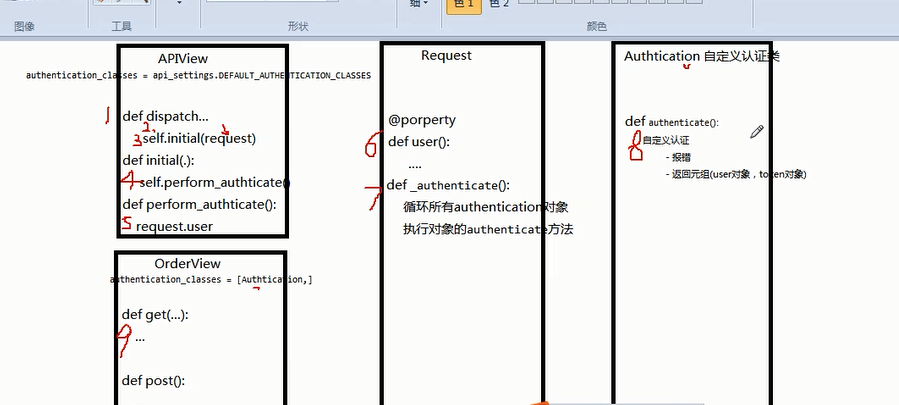
请求先到dispatch
dispatch()主要做了两件事
- 封装request
- 认证
具体看我写的代码里面的注释
def dispatch(self, request, *args, **kwargs):
"""
`.dispatch()` is pretty much the same as Django's regular dispatch,
but with extra hooks for startup, finalize, and exception handling.
"""
self.args = args
self.kwargs = kwargs
#对原始request进行加工,丰富了一些功能
#Request(
# request,
# parsers=self.get_parsers(),
# authenticators=self.get_authenticators(),
# negotiator=self.get_content_negotiator(),
# parser_context=parser_context
# )
#request(原始request,[BasicAuthentications对象,])
#获取原生request,request._request
#获取认证类的对象,request.authticators
#1.封装request
request = self.initialize_request(request, *args, **kwargs)
self.request = request
self.headers = self.default_response_headers # deprecate?
try:
#2.认证
self.initial(request, *args, **kwargs)
# Get the appropriate handler method
if request.method.lower() in self.http_method_names:
handler = getattr(self, request.method.lower(),
self.http_method_not_allowed)
else:
handler = self.http_method_not_allowed
response = handler(request, *args, **kwargs)
except Exception as exc:
response = self.handle_exception(exc)
self.response = self.finalize_response(request, response, *args, **kwargs)
return self.response
4.1.reuqest
(1)initialize_request()
可以看到initialize()就是封装原始request
def initialize_request(self, request, *args, **kwargs):
"""
Returns the initial request object.
"""
parser_context = self.get_parser_context(request)
return Request(
request,
parsers=self.get_parsers(),
#[BasicAuthentication(),],把对象封装到request里面了
authenticators=self.get_authenticators(),
negotiator=self.get_content_negotiator(), parser_context=parser_context )
(2)get_authenticators()
通过列表生成式,返回对象的列表
def get_authenticators(self):
"""
Instantiates and returns the list of authenticators that this view can use.
"""
return [auth() for auth in self.authentication_classes]
(3)authentication_classes
APIView里面有个 authentication_classes 字段
可以看到默认是去全局的配置文件找(api_settings)
class APIView(View):
# The following policies may be set at either globally, or per-view.
renderer_classes = api_settings.DEFAULT_RENDERER_CLASSES
parser_classes = api_settings.DEFAULT_PARSER_CLASSES
authentication_classes = api_settings.DEFAULT_AUTHENTICATION_CLASSES
throttle_classes = api_settings.DEFAULT_THROTTLE_CLASSES
permission_classes = api_settings.DEFAULT_PERMISSION_CLASSES
content_negotiation_class = api_settings.DEFAULT_CONTENT_NEGOTIATION_CLASS
metadata_class = api_settings.DEFAULT_METADATA_CLASS
versioning_class = api_settings.DEFAULT_VERSIONING_CLASS
4.2.认证
self.initial(request, *args, **kwargs)
def dispatch(self, request, *args, **kwargs):
"""
`.dispatch()` is pretty much the same as Django's regular dispatch,
but with extra hooks for startup, finalize, and exception handling.
"""
self.args = args
self.kwargs = kwargs
#对原始request进行加工,丰富了一些功能
#Request(
# request,
# parsers=self.get_parsers(),
# authenticators=self.get_authenticators(),
# negotiator=self.get_content_negotiator(),
# parser_context=parser_context
# )
#request(原始request,[BasicAuthentications对象,])
#获取原生request,request._request
#获取认证类的对象,request.authticators
#1.封装request
request = self.initialize_request(request, *args, **kwargs)
self.request = request
self.headers = self.default_response_headers # deprecate?
try:
#2.认证
self.initial(request, *args, **kwargs)
# Get the appropriate handler method
if request.method.lower() in self.http_method_names:
handler = getattr(self, request.method.lower(),
self.http_method_not_allowed)
else:
handler = self.http_method_not_allowed
response = handler(request, *args, **kwargs)
except Exception as exc:
response = self.handle_exception(exc)
self.response = self.finalize_response(request, response, *args, **kwargs)
return self.response
(1)initial()
主要看 self.perform_authentication(request),实现认证
def initial(self, request, *args, **kwargs):
"""
Runs anything that needs to occur prior to calling the method handler.
"""
self.format_kwarg = self.get_format_suffix(**kwargs)
# Perform content negotiation and store the accepted info on the request
neg = self.perform_content_negotiation(request)
request.accepted_renderer, request.accepted_media_type = neg
# Determine the API version, if versioning is in use.
version, scheme = self.determine_version(request, *args, **kwargs)
request.version, request.versioning_scheme = version, scheme
# Ensure that the incoming request is permitted
#3.实现认证
self.perform_authentication(request)
self.check_permissions(request)
self.check_throttles(request)
(2)perform_authentication()
调用了request.user
def perform_authentication(self, request):
"""
Perform authentication on the incoming request.
Note that if you override this and simply 'pass', then authentication
will instead be performed lazily, the first time either
`request.user` or `request.auth` is accessed.
"""
request.user
(3)user
request.user的request的位置

点进去可以看到Request有个user方法,加 @property 表示调用user方法的时候不需要加括号“user()”,可以直接调用:request.user
@property
def user(self):
"""
Returns the user associated with the current request, as authenticated
by the authentication classes provided to the request.
"""
if not hasattr(self, '_user'):
with wrap_attributeerrors():
#获取认证对象,进行一步步的认证
self._authenticate()
return self._user
(4)_authenticate()
循环所有authenticator对象
def _authenticate(self):
"""
Attempt to authenticate the request using each authentication instance
in turn.
"""
#循环认证类的所有对象
#执行对象的authenticate方法
for authenticator in self.authenticators:
try:
#执行认证类的authenticate方法
#这里分三种情况
#1.如果authenticate方法抛出异常,self._not_authenticated()执行
#2.有返回值,必须是元组:(request.user,request.auth)
#3.返回None,表示当前认证不处理,等下一个认证来处理
user_auth_tuple = authenticator.authenticate(self)
except exceptions.APIException:
self._not_authenticated()
raise
if user_auth_tuple is not None:
self._authenticator = authenticator
self.user, self.auth = user_auth_tuple
return
self._not_authenticated()
返回值就是例子中的:
token_obj.user-->>request.user
token_obj-->>request.auth
#在rest framework内部会将这两个字段赋值给request,以供后续操作使用
return (token_obj.user,token_obj) #例子中的return
当都没有返回值,就执行self._not_authenticated(),相当于匿名用户,没有通过认证
def _not_authenticated(self):
"""
Set authenticator, user & authtoken representing an unauthenticated request.
Defaults are None, AnonymousUser & None.
"""
self._authenticator = None
if api_settings.UNAUTHENTICATED_USER:
self.user = api_settings.UNAUTHENTICATED_USER() #AnonymousUser匿名用户
else:
self.user = None
if api_settings.UNAUTHENTICATED_TOKEN:
self.auth = api_settings.UNAUTHENTICATED_TOKEN() #None
else:
self.auth = None
面向对象知识:
子类继承 父类,调用方法的时候:
- 优先去自己里面找有没有这个方法,有就执行自己的
- 只有当自己里面没有这个方法的时候才会去父类找
因为authenticate方法我们自己写,所以当执行authenticate()的时候就是执行我们自己写的认证
父类中的authenticate方法
def authenticate(self, request):
return (self.force_user, self.force_token)
我们自己写的
class Authentication(APIView):
'''用于用户登录验证'''
def authenticate(self,request):
token = request._request.GET.get('token')
token_obj = models.UserToken.objects.filter(token=token).first()
if not token_obj:
raise exceptions.AuthenticationFailed('用户认证失败')
#在rest framework内部会将这两个字段赋值给request,以供后续操作使用
return (token_obj.user,token_obj)
认证的流程就是上面写的,弄懂了原理,再写代码就更容易理解为什么了。
4.3.配置文件
继续解读源码

默认是去全局配置文件中找,所以我们应该在settings.py中配置好路径
api_settings源码
api_settings = APISettings(None, DEFAULTS, IMPORT_STRINGS)
def reload_api_settings(*args, **kwargs):
setting = kwargs['setting']
if setting == 'REST_FRAMEWORK':
api_settings.reload()
setting中‘REST_FRAMEWORK’中找
全局配置方法:
API文件夹下面新建文件夹utils,再新建auth.py文件,里面写上认证的类
settings.py
#设置全局认证
REST_FRAMEWORK = {
"DEFAULT_AUTHENTICATION_CLASSES":['API.utils.auth.Authentication',] #里面写你的认证的类的路径
}
auth.py
# API/utils/auth.py
from rest_framework import exceptions
from API import models
class Authentication(object):
'''用于用户登录验证'''
def authenticate(self,request):
token = request._request.GET.get('token')
token_obj = models.UserToken.objects.filter(token=token).first()
if not token_obj:
raise exceptions.AuthenticationFailed('用户认证失败')
#在rest framework内部会将这两个字段赋值给request,以供后续操作使用
return (token_obj.user,token_obj)
def authenticate_header(self, request):
pass
在settings里面设置的全局认证,所有业务都需要经过认证,如果想让某个不需要认证,只需要在其中添加下面的代码:
authentication_classes = [] #里面为空,代表不需要认证
from django.shortcuts import render,HttpResponse
from django.http import JsonResponse
from rest_framework.views import APIView
from API import models
from rest_framework.request import Request
from rest_framework import exceptions
from rest_framework.authentication import BasicAuthentication
ORDER_DICT = {
1:{
'name':'apple',
'price':15
},
2:{
'name':'dog',
'price':100
}
}
def md5(user):
import hashlib
import time
#当前时间,相当于生成一个随机的字符串
ctime = str(time.time())
m = hashlib.md5(bytes(user,encoding='utf-8'))
m.update(bytes(ctime,encoding='utf-8'))
return m.hexdigest()
class AuthView(APIView):
'''用于用户登录验证'''
authentication_classes = [] #里面为空,代表不需要认证
def post(self,request,*args,**kwargs):
ret = {'code':1000,'msg':None}
try:
user = request._request.POST.get('username')
pwd = request._request.POST.get('password')
obj = models.UserInfo.objects.filter(username=user,password=pwd).first()
if not obj:
ret['code'] = 1001
ret['msg'] = '用户名或密码错误'
#为用户创建token
token = md5(user)
#存在就更新,不存在就创建
models.UserToken.objects.update_or_create(user=obj,defaults={'token':token})
ret['token'] = token
except Exception as e:
ret['code'] = 1002
ret['msg'] = '请求异常'
return JsonResponse(ret)
class OrderView(APIView):
'''订单相关业务'''
def get(self,request,*args,**kwargs):
# self.dispatch
#request.user
#request.auth
ret = {'code':1000,'msg':None,'data':None}
try:
ret['data'] = ORDER_DICT
except Exception as e:
pass
return JsonResponse(ret)
API/view.py代码
再测试一下我们的代码
不带token发请求
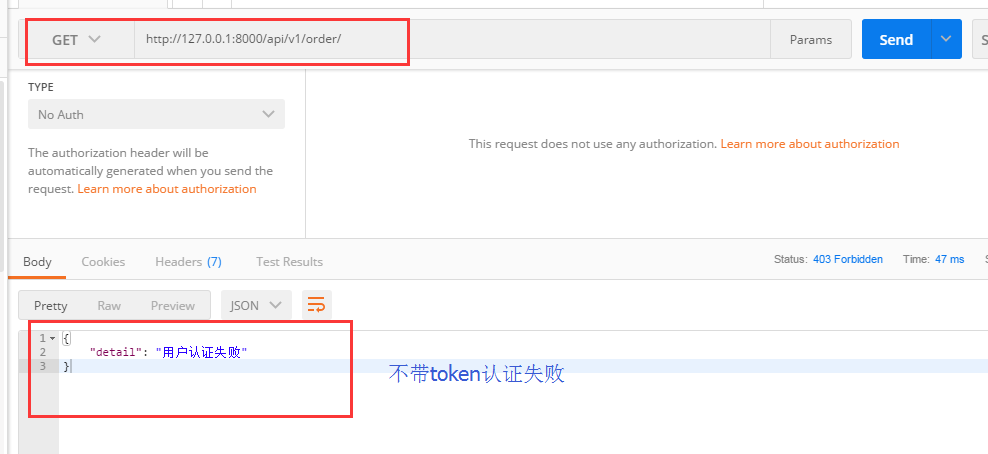
带token发请求
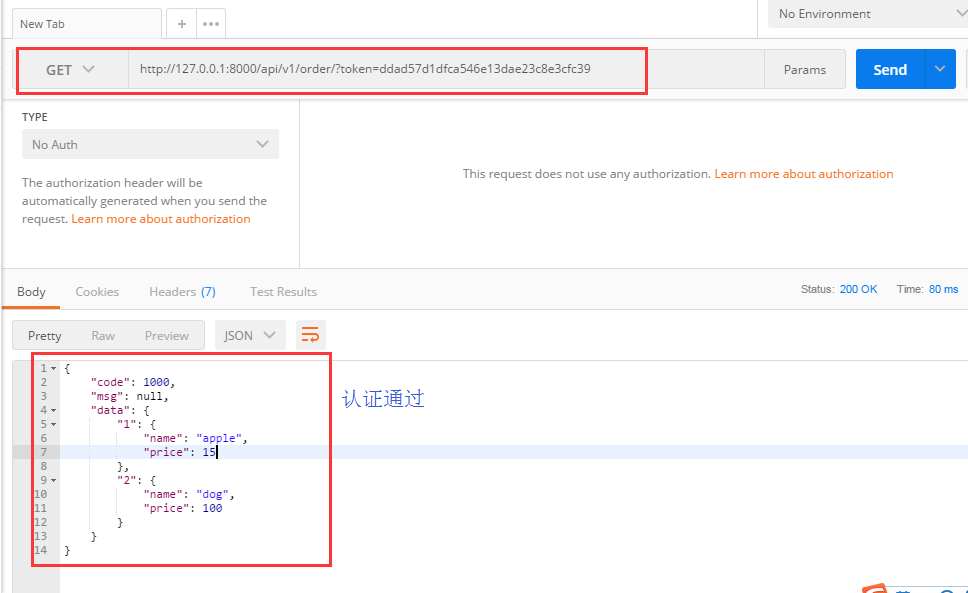
五、drf的内置认证
rest_framework里面内置了一些认证,我们自己写的认证类都要继承内置认证类 "BaseAuthentication"
4.1.BaseAuthentication源码:
class BaseAuthentication(object):
"""
All authentication classes should extend BaseAuthentication.
"""
def authenticate(self, request):
"""
Authenticate the request and return a two-tuple of (user, token).
"""
#内置的认证类,authenticate方法,如果不自己写,默认则抛出异常
raise NotImplementedError(".authenticate() must be overridden.")
def authenticate_header(self, request):
"""
Return a string to be used as the value of the `WWW-Authenticate`
header in a `401 Unauthenticated` response, or `None` if the
authentication scheme should return `403 Permission Denied` responses.
"""
#authenticate_header方法,作用是当认证失败的时候,返回的响应头
pass
4.2.修改自己写的认证类
自己写的Authentication必须继承内置认证类BaseAuthentication
# API/utils/auth/py
from rest_framework import exceptions
from API import models
from rest_framework.authentication import BaseAuthentication
class Authentication(BaseAuthentication):
'''用于用户登录验证'''
def authenticate(self,request):
token = request._request.GET.get('token')
token_obj = models.UserToken.objects.filter(token=token).first()
if not token_obj:
raise exceptions.AuthenticationFailed('用户认证失败')
#在rest framework内部会将这两个字段赋值给request,以供后续操作使用
return (token_obj.user,token_obj)
def authenticate_header(self, request):
pass
4.3.其它内置认证类
rest_framework里面还内置了其它认证类,我们主要用到的就是BaseAuthentication,剩下的很少用到
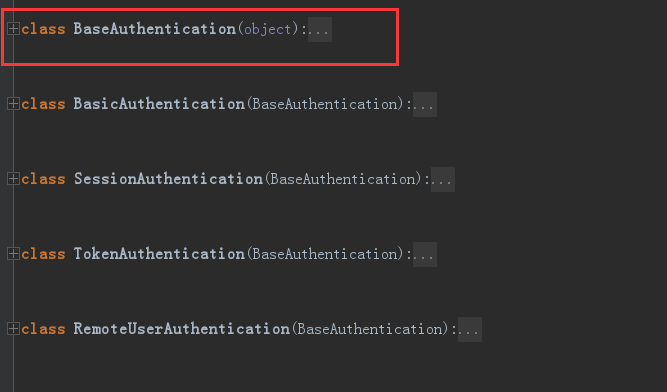
六、总结
自己写认证类方法梳理
(1)创建认证类
- 继承BaseAuthentication --->>1.重写authenticate方法;2.authenticate_header方法直接写pass就可以(这个方法必须写)
(2)authenticate()返回值(三种)
- None ----->>>当前认证不管,等下一个认证来执行
- raise exceptions.AuthenticationFailed('用户认证失败') # from rest_framework import exceptions
- 有返回值元祖形式:(元素1,元素2) #元素1复制给request.user; 元素2复制给request.auth
(3)局部使用
- authentication_classes = [BaseAuthentication,]
(4)全局使用
#设置全局认证
REST_FRAMEWORK = {
"DEFAULT_AUTHENTICATION_CLASSES":['API.utils.auth.Authentication',]
}
源码流程
--->>dispatch
--封装request
---获取定义的认证类(全局/局部),通过列表生成式创建对象
---initial
----peform_authentication
-----request.user (每部循环创建的对象)
10.DRF-认证的更多相关文章
- DRF 认证、权限、限制
DRF 认证.权限.限制 认证: 定义一个用户表和一个保存用户的Token表 # ======================day96======================= class ...
- python 全栈开发,Day97(Token 认证的来龙去脉,DRF认证,DRF权限,DRF节流)
昨日内容回顾 1. 五个葫芦娃和三行代码 APIView(views.View) 1. 封装了Django的request - request.query_params --> 取URL中的参数 ...
- (四) DRF认证, 权限, 节流
一.Token 认证的来龙去脉 摘要 Token 是在服务端产生的.如果前端使用用户名/密码向服务端请求认证,服务端认证成功,那么在服务端会返回 Token 给前端.前端可以在每次请求的时候带上 To ...
- drf认证组件、权限组件、jwt认证、签发、jwt框架使用
目录 一.注册接口 urls.py views.py serializers.py 二.登录接口 三.用户中心接口(权限校验) urls.py views.py serializers.py 四.图书 ...
- DRF认证组件
1.DRF认证组件之视图注册用法(自定义简单使用) settings.py配置 INSTALLED_APPS = [ 'django.contrib.admin', 'django.contrib.a ...
- drf 认证功能
drf(django rest-framework)认证组件 复习 HyperlinkedIdentityField ```python 功能:快速生成连接 1. publish = seriali ...
- 【DRF认证】
目录 认证组件的详细用法 本文详细讲述了DRF认证组件的原理以及用法. @ * 源码剖析** 上一篇博客讲解DRF版本的时候我们都知道了,在dispatch方法里执行了initial方法来初始化我们的 ...
- 三 drf 认证,权限,限流,过滤,排序,分页,异常处理,接口文档,集xadmin的使用
因为接下来的功能中需要使用到登陆功能,所以我们使用django内置admin站点并创建一个管理员. python manage.py createsuperuser 创建管理员以后,访问admin站点 ...
- drf 认证、权限、限流、过滤、排序、分页器
认证Authentication 准备工作:(需要结合权限用) 1. 需要使用到登陆功能,所以我们使用django内置admin站点并创建一个管理员. python manage.py creates ...
- Django -- DRF 认证流程
Django Restful Framework (DRF)中类的调用与自定义-- 以 autentication 认证为例 DRF 的 request 对 django 的 request 进行了更 ...
随机推荐
- 项目readme文件目录生成工具 treer
生成目录的工具呢有tree和treer,但是tree不知道怎么忽略node_modules文件夹, 而treer就简单了,下面就是基本的命令了 其中-i是指忽略xxx, -e是指导出 安装 npm i ...
- HTTP——无状态协议理解
无状态服务器是指一种把每个请求作为与之前任何请求都无关的独立的事务的服务器. HTTP是一个属于应用层的面向对象的协议 ------未完待续
- httppost的用法
一,案例一 定义了一个list,该list的数据类型是NameValuePair(简单名称值对节点类型),这个代码多处用于Java像url发送Post请求.在发送post请求时用该list来存放参数. ...
- 【Ubuntu】快捷键
版本:Ubuntu18.04 1. 终端(terminal ) alt + ctrl + t # 打开终端 shift + shift + t # 新建终端标签页 ctrl + c # 强制停止程序运 ...
- Java中的集合(四)PriorityQueue常用方法
Java中的集合(四)PriorityQueue常用方法 PriorityQueue的基本概念等都在上一篇已说明,感兴趣的可以点击 Java中的集合(三)继承Collection的Queue接口 查看 ...
- leetcode198之打家劫舍问题
问题描述: 你是一个专业的小偷,计划偷窃沿街的房屋.每间房内都藏有一定的现金,影响你偷窃的唯一制约因素就是相邻的房屋装有相互连通的防盗系统,如果两间相邻的房屋在同一晚上被小偷闯入,系统会自动报警. 给 ...
- 一文彻底搞懂BERT
一.什么是BERT? 没错下图中的小黄人就是文本的主角Bert ,而红色的小红人你应该也听过,他就是ELMo.2018年发布的BERT 是一个 NLP 任务的里程碑式模型,它的发布势必会带来一个 NL ...
- python调用大漠插件教程04鼠键事件及基本项目思维
from win32com.client import Dispatch import os from random import uniform from time import sleep cla ...
- 【Linux】ntp服务-时间同步
ntp简易安装与时间同步 yum -y install ntp ntpdate //安装ntp服务 ntpdate cn.pool.ntp.org //更新时间 hwclock --systohc / ...
- vue+jquery使用FormData向后端传递数据和文件,express如何获取
使用multiparty 模块 下载 cnpm install multiparty --save 前端代码: <template> <div class="add-are ...
